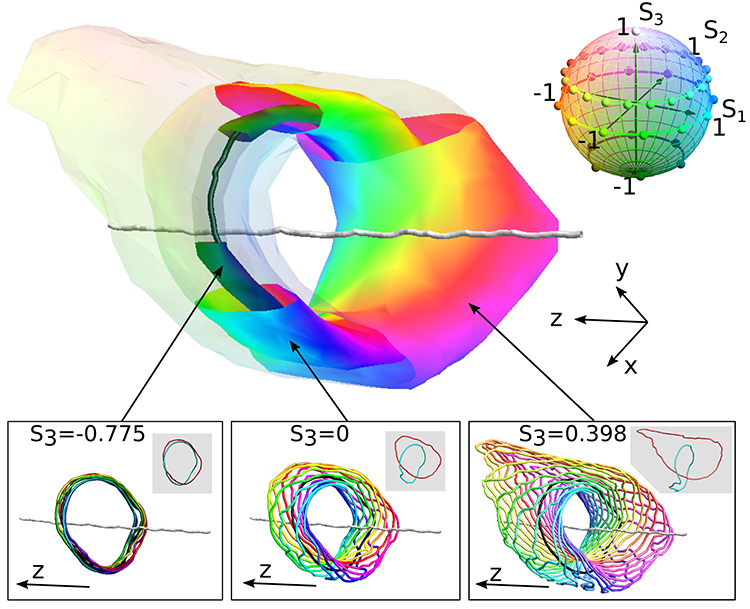 Top right: A Poincaré sphere color coded for all polarization states. The S3 axis is connected to the saturation which leads to darker, brighter colors. Top left: All states of polarization with the same ellipticity value (S3) taken together form a torus. Bottom: Each torus is independently shown as a fibration of representative fixed states of polarizations. The fibration reveals that each fiber, formed by the same state of polarization, is a loop linked exactly once to all other fibers, leading to the Skyrme number close to 1.
Top right: A Poincaré sphere color coded for all polarization states. The S3 axis is connected to the saturation which leads to darker, brighter colors. Top left: All states of polarization with the same ellipticity value (S3) taken together form a torus. Bottom: Each torus is independently shown as a fibration of representative fixed states of polarizations. The fibration reveals that each fiber, formed by the same state of polarization, is a loop linked exactly once to all other fibers, leading to the Skyrme number close to 1.
Three-dimensional (3D) topological objects possess unique features not found in lower-dimensional spaces since they resemble localized, particle-like objects in space. Among the richest such structures are skyrmions, first discovered in high-energy physics, and hopfions, known as paradigmatic knotted solitons.1,2 Recently, we were able to create a 3D skyrmionic hopfion experimentally in light, and measure its mapping into three dimensions in detail.3
Skyrmions and hopfions have received tremendous attention as exotic textures in particle physics, cosmology, superfluids and many other systems. A full characterization of their topological properties is highly challenging, and attention has focused on much simpler, planar analogs as 2D magnetic-based skyrmions.
Optical realizations of 3D topological states can take various forms, including singularity lines, such as optical vortices or polarization singularities. At these singular locations, a light field carries topological charge, its strength being defined by the surrounding complex field. In fully structured light, where amplitude, phase and polarization are spatially varied, singularity lines can be woven into loops, links and knots or are organized within polarization Möbius strips.4,5
The state of circular polarization along such singularity lines is often described as the skeleton of a complex optical polarization field. Topologically structured light has a wide range of applications including enhanced free-space optical communications, improved nanoscale resolution and advanced trapping, and is related to optical currents and orbital angular momentum.
In our recent work, by simultaneously tailoring the polarization and the phase profile, we realized every possible optical state in the propagation volume, establishing skyrmionic mapping to an optical hypersphere. The Stokes parameters and phases of the resulting light fields are synthesized into a Hopf fibration texture. We performed volumetric full-field reconstruction to measure a topological charge, or Skyrme number, of 0.945, which is close to the theoretical value of 0.997 for the same boundary conditions.
Such topological-state metrology opens new avenues for multidimensional optical data encoding and information processing. The Hopf characterization of the hypersphere endows a new perspective to topological optics, offering experimentally accessible photonic analogues to complement the full gamut of 3D topological textures, from condensed matter to high-energy physics.
Researchers
Ramon Droop, Eileen Otte, Daniel Ehrmanntraut and Cornelia Denz, University of Muenster, Muenster, Germany
Danica Sugic, RIKEN, Saitama, Japan; University of Birmingham, Birmingham, and University of Bristol, Bristol, UK
Franco Nori, RIKEN, Saitama, Japan; University of Michigan, Ann Arbor, MI, USA
Janne Ruostekoski, Lancaster University, Lancaster, UK
Mark R. Dennis, University of Birmingham and University of Bristol, UK
References
1. T.H.R. Skyrme. Proc. R. Soc. A 260, 127 (1961).
2. H. Urbantke. J. Geom. Phys. 46, 125 (2003).
3. D. Sugic et al. Nat. Commun, doi: 10.1038/s41467-021-26171-5 (2021).
4. H. Rubinsztein-Dunlop et al. J. Opt. 19, 013001 (2017).
5. M.R. Dennis et al. Nat. Phys. 6, 118 (2010).
